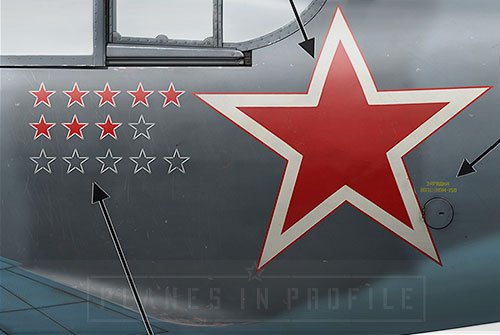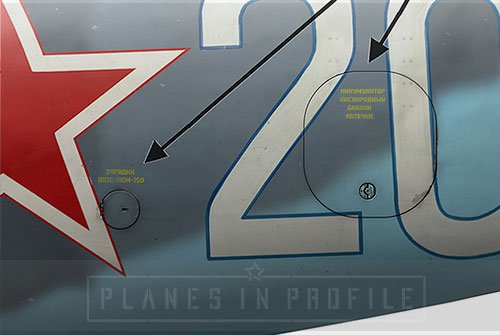Haustov’s White-20
Lavochkin, La-5F (Type 39)
21-st (Vitebskiy)IAP , 259-th IAD, 3-rd Air Army, 1-st Prebaltic Front, probably circa. March-April 1944.
Flown by the commander of a squadron, captain Ivan Ivanovich Haustov. (An Ace with 22 victories, 10 personal and 12 shared)[1]
Ivan Haustov began his service with the 21st IAP in September 1943, taking up a position of a squadron commander in the regiment which was equipped with La-5 airplanes. By that time the 26 year old Ivan Haustov was already an experienced fighter Ace who began his military career back in the days of the Winter War with Finland where he flew an I-153 biplane. He also flew MiG-3, Hurricane and Yak-7 airplanes before joining the 21st IAP. By October 1943 (around the time he joined the 21st IAP), according to his awards list, Haustov already flew 306 sorties, in air battles he shot down 7 airplanes personally and 13 as part of a group.
Once in the 21st IAP, flying a La-5, Haustov went on to score 5 more personal victories, these were:
06.02.1944 1 x FW 190 south-east of lake Zaronovskoe (Belarus), or near Shyshki (Belarus) according to Haustov’s award list.
01.05.1944 1 x HS-126. south of Knyazevo.(Belarus)
24.06.1944 1 x FW 190 Valyushyna. (Belarus), or Vamoshyno (Belarus) according to Haustov’s award list.
28.07.1944 2 x FW 190. Skapishkis (Lithuania), or Rakitkis (Lithuania) according to Haustov’s award list. [1]
The first three victories above earned Haustov an Order of Alexandr Nevskiy. His award list describes them as follows:
‘ 6.2.44. As part of 4 La-5, while escorting Shturmoviks, engaged in battle with 2 FW-190, as a result of it comrade Haustov personally downed one FW-190, which fell in the area of the village Shyshki.
The downing of the airplane was confirmed by the order of 259 IAGD no. 029 on 13.2.441.5.44 comrade Haustov in a pair with jun. lieutenant Artem’ev, during a free-hunting sortie met 1 Hs-126. As a result of an air battle Hs-126 was downed by comrade Haustov and while burning fell east of Knyazevo.
The downing of the airplane was confirmed by jun. lieutenant Artem’ev.24.6.44. While escorting Shturmoviks, engaged in an air battle with FW-190. As a result of the air battle comrade Haustov personally downed one FW-190, the plane fell in the area of the Vamoshyno village, which is south east of the Goryany station.
The downing of the airplane was confirmed by the wingman jun. lieutenant Shaplyko. [2]
The same award list goes on to say the following about Haustov and his squadron:
The squadron under the command of comrade Haustov, during this period (meaning the period from 9 October 1944 to 24 June 1944) flew 758 successful battle sorties, out of which 400 were reconnaissance sorties. During the air battles that it engaged in, the squadron downed 5 enemy airplanes. Their own losses for that period : airplane accident - 1, no personnel losses.
Comrade Haustov’s highly skilled battle work in the destruction of the Germano-fascist invaders sets an example to the whole personnel of the regiment. Brave, resourceful, courageous fighter pilot. In air battles he always remains victorious.
In general, when executing the battle tasks of the squadron in regards to the reconnaissance of the enemy troops, the personnel fluently mastered the task of reconnaissance of enemy troops and always, in each sortie, gathers valuable intelligence about the enemy.
Personally comrade Haustov masterfully performs reconnaissance flights, despite enemy fire, persistently continues to gather intelligence about the communications and actions of the enemy troops.
In the period from 22.6.44, in battles around the Vitebsk sector, the flight crew displays high standards in battle work. In 4 days of intense battles the squadron works without losses and incidents.’ [2]
For its exceptional performance in battles to re-take the city of Vitebsk(Belarus) from the fascist invaders, on the 10th of July 1944 the 21st IAP received an honorary title of ‘Vitebskiy’.
The last two victories in the list above, occurred in one battle sortie, a feat which earned Haustov his second Order of the Red Banner decoration. The event is described in his award list:
‘28.7.44 As part of 6 La-5, under the command of captain Haustov, while escorting the Shturmoviks of the 332 ShAD in the area of their destination, have met 10 FW-190. A fierce air battle ensued, as a result of which the group of captain Haustov shot down 5 FW-190, 2 of these FW-190 were shot down personally by captain Haustov. Both planes, while on fire, fell in the area of Rokitkis. The group of captain Haustov and the Shturmovik’s did not sustain any losses.
The downing of the airplanes was confirmed by the participating pilots of the fighters and Shturmoviks. [3]
The same award list also said the following about Haustov:
‘…In executing the orders of the Commanders regarding the destruction of the Germano-fascist invaders, comrade Haustov proved himself to be a good organiser in battle work, able supervisor of air battle. Brave and resourceful fighter pilot.
As a one-man chief commander, he shows maximum care about his subordinates, raising battle spirit of the flight crew for the execution of battle orders.
The flight crew of the squadron flawlessly, despite the difficulties in their work, speedily restores damaged airplanes and in a timely manner prepares them for battle sorties. ‘ [3]
It’s worth noting that the overall number of victory starlets (personal +shared) on Haustov’s airplane doesn’t correspond to the overall victories (personal +shared) mentioned in Haustov’s award list, nor to the victories based on Mikhail Bykov’s research. If we will consider Haustov’s personal victories only, of which we can see 8 starlets on the airplane, and if we’ll take into account the fact that the photo doesn’t show any snow on the ground, that would imply that the photo of White-20 with the starlets on it, was most likely taken sometime in late March or April 1944. Other sources mention that Haustov flew the White-20 in the summer of that year also, implying that all the victories that Haustov scored while serving with the 21st IAP were likely scored from behind the controls of White-20. From December 1944, 21st IAP started to receive their La-7 airplanes and Haustov is though to have flown a La-7 from roughly around that time onwards. He is not known to have scored any victories in a La-7.
On the 6th of March 1945, by which time Ivan Ivanovich Haustov was promoted to a Major and a navigator of the 21st IAP, he did not return from a battle sortie. He is listed as M.I.A.
Noteworthy visual characteristics
General) The airplane was painted Grey, with slight variations to the usual Grey/Grey camo. The stars are in the usual 6 positions. Based on some of the visual characteristics, the plane appears to have been built at factory 318, though the serial number of this plane is unknown in order to confirm this. The plane might have been up to 6 months old at the time of the photograph, so there was definitely some weathering and paint chipping on it.
1) Please note that the ‘La-5F’ logo which usually appears in the area indicated by the arrow is absent.
2) The cowl flap appears to be only partially painted. Note a light vertical line at the base of the cowl flap (Indicated by the arrow), it’s probably some chipped-off paint exposing bare metal.
3) The engine cowling was probably covered with AMT-12 (Grey) completely (except for the bottom of the plane), which is not in keeping with the most common Grey/Grey camo. pattern.
4) The large star seems to be a bit larger than usual and the top part of the star appears to be shorter than the other parts.
5) The starlets represent Haustov’s victories, possibly at around late March/April 1944 based on the 8 personal victories. Red starlets represent personal victories. Hollow stars represent shared victories. It’s worth noting that the number of personal victory starlets doesn’t correspond with the correct number of shared victory starlets. At the time when Haustov had 8 personal victories his shared victories score stood at around 13 according to Haustov’s award list, or 12 according to the victories based on Mikhail Bykov’s research, but according to the photo reference we can only see 6 shared victories starlets.
The victory starlets might have also appeared on the right side of the airplane. This is based on the fact that victory starlets can be observed on the right side of some other planes of the 21st IAP, such as Galchenko’s White-18.
6) The technical markings aren’t clearly seen in the photo reference. It’s possible that they were completely absent. There is also a chance that they might have been ‘yellow’ which is why they are the same in tone as the background colour in the B/W photos.
7) The spinner was most likely ‘red’ because the tone of the spinner appears to be the same as that of the stars in the two different photos of White-20 (As per below). There is no existing info to suggest that the spinners of the 21st IAP were painted with a specific ‘regimental’ colour. Indeed, the planes of the 21st IAP seem to have spinners of various different colours.
Here are a few close-up images to help illustrate the points above. Full set of close-up images is On Patreon
FOOTNOTES
[1] The number of victories is based on the research by Mikhail Bykov, , in his book ‘Все асы Сталина 1936–1953 гг’ [All aces of Stalin 1936-1953]. Moscow: Yauza, ISBN 978-5-9955-0712-3 . page 1252-1253
[2] Info is based on Haustov’s award list http://podvignaroda.ru/?#id=34738723&tab=navDetailManAward
[3] Info is based on Haustov’s award list http://podvignaroda.ru/?#id=45806785&tab=navDetailManAward
LINKS TO THE REFERENCE IMAGES AND VIDEOS
A plane which is most likely Haustov’s White-20 before it had the victory starlets painted on it.
http://ava.org.ru/iap/21/la5f_20-1943.jpg
A photo of Haustov’s White-20 with the victory starlets painted on it
http://ava.org.ru/iap/21/la5f_20_haustov.jpg
All the work presented on this is page is subject to updates and revisions in the light of new information which might present itself. If you have any new information relevant to this page or disagree with anything that's presented here, then please feel free to contact me through the Planes in Profile Facebook page. Thanks:)






